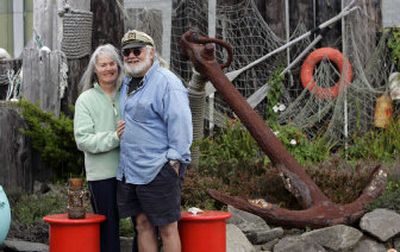Finding flotsam, and then some

NEWPORT, Ore. – The ocean is a fickle giver of strange gifts. Miserly for days on end, it can with a single storm turn generous, casting a line of treasure free for the taking along a beach.
Of course, treasure is in the eye of the beholder. The ocean’s gifts usually come barnacle-encrusted and seaweed-tangled, battered by wave, wind and salt. But those with an eye for unusual beauty and an ear for salty tales rarely come away from the beach unrewarded.
Call them flotsamists.
John Crowe at times is a flotsamist, although he doesn’t think of himself quite that way. A 50-year veteran of the commercial diving trade who’s lived nearly his whole life on one beach or another, Crowe is surrounded by flotsam. And jetsam. And lagan.
The home he and his wife, Patty, share on Newport’s Nye Beach is piled with it: floats from crab pots and fishing nets, ancient lengths of chain, a coil of rope, buoys, anchors, hatch doors, life rings. Some he picked from the sea bottom during his diving days, some from beaches he has walked untold times.
“I used to go every single day that I could, really just to walk on the beach,” he says, turning to look out the front window of his rental cabin at the mild surf. “But I never passed up anything. I was always happy to find whatever was left for me.”
That makes Crowe a flotsamist in Skye Moody’s book. Moody is the author of the recently published “Washed Up: The Curious Journey of Flotsam and Jetsam,” a mix of natural history and field guide to the ocean’s largesse.
Crowe is one of many flotsamists in Moody’s book. It’s a pastime defined by a sense of wonder and imagination sparked as much by the sea’s gifts themselves as the stories behind them.
So by all means call Moody a flotsamist. Just don’t call her a beachcomber.
“Beachcombers in general, they just don’t recognize real treasure,” says Moody, a Seattle author and lifetime beach treasure hunter. “To me, beachcombers are out there in a very casual sense; they’re on the beach to relax, and if they’re out there looking, they’re usually looking for pretty shells or rocks.
“But if they’re a flotsamist, they’re looking for mostly man-made objects that came far and traveled on interesting currents – objects with a story.”
Those currents are what turn an otherwise mundane bit of detritus into treasure. Think: A wreck at sea, or storm-tossed waves raking cargo containers from a deck, or currents spinning everyday objects – a child’s plastic toy, a foreign-labeled bottle, a wallet – onto a journey over thousands of miles that happens to end at the beach you are on, at the time you are on it.
“I think with everybody who finds something floating up and washing up on the beach, it is the wonder of discovery that makes it treasure,” Moody says. “It is as if the sea sent me personally a gift. I found it; it was meant for me.”
In the lexicon of flotsamists, Moody writes, treasure comes in three kinds. Flotsam is the wreckage of a ship or its cargo that floats in on the waves; jetsam is items discarded or thrown overboard, perhaps to lighten a boat in distress; and lagan is goods or wreckage lying on the ocean floor, which also sometimes washes ashore.
Although it often amounts to an everyday item imbued with the patina of time and distance, flotsam can have the beauty of fine art or even the worth of real treasure. Japanese fishing floats still occasionally wash up on Oregon beaches as prized finds, and Moody says that in some parts of the world, flotsamists still turn up the odd doubloon or gold coin from a near-shore shipwreck.
About the only trick to finding flotsam and its brethren is to be first on the beach after a high tide, particularly after a storm. Or during it. A hard-core flotsamist is the one walking the wrack line marking high tide when he or she has to face backward against wind and rain.
And this is the time of year they wait for, when the calm seas of summer turn rough. Crowe isn’t quite the purist. He doesn’t turn down, say, an interesting piece of driftwood. What he shares with Moody and other flotsamists is curiosity and imagination.
Take a particular anchor he pulled up from the bottom near Sunset Beach in Southern California, an old-style anchor that dates to the time of Prohibition or earlier that has a length of chain to which are attached a set of handcuffs and leg irons. “I’ve often wondered about that one,” he says.